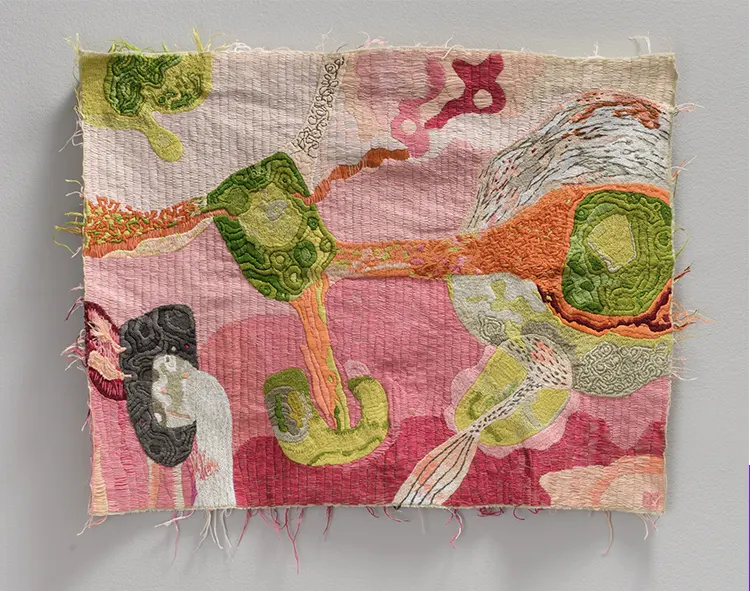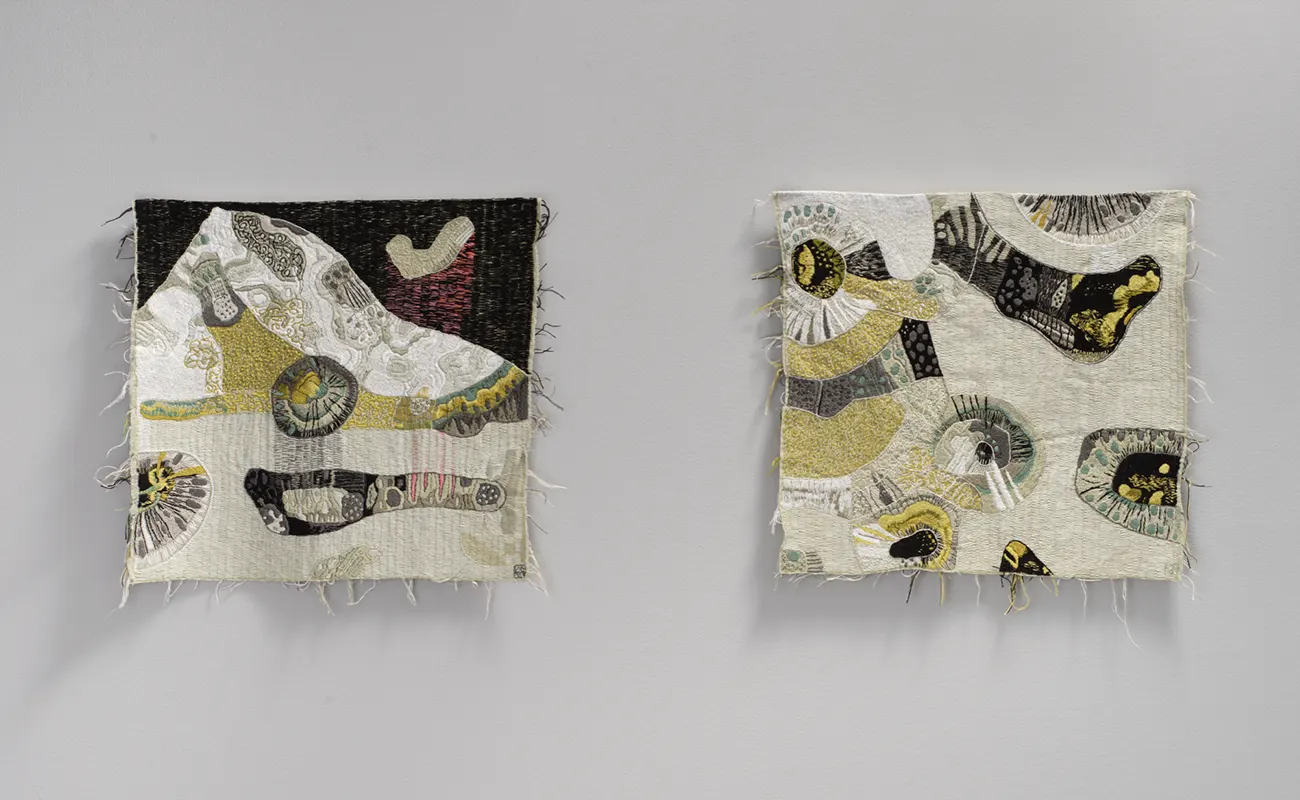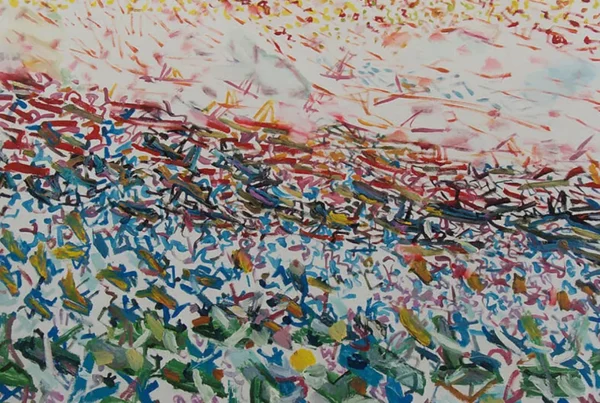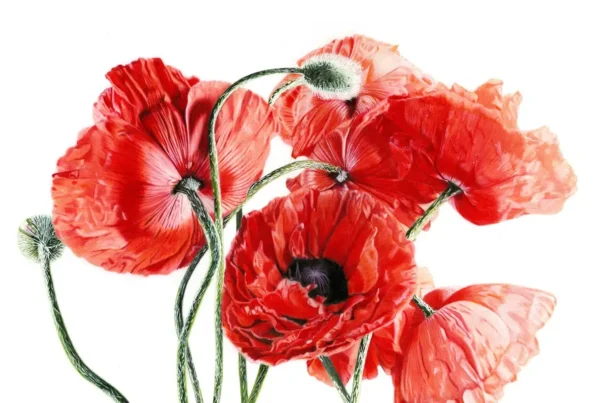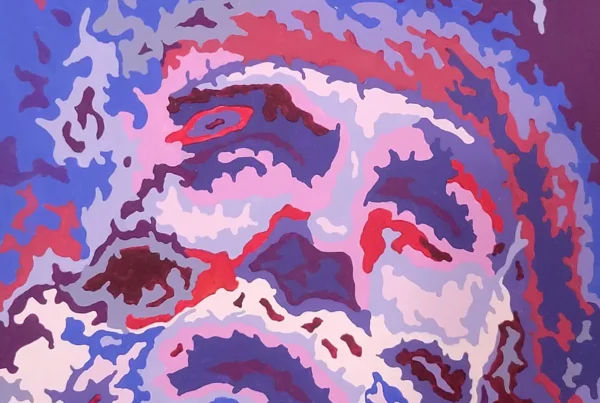“I am concerned with the tactile and touching. Feeling the warmth of a rock in the sun, holding a pebble in my hand, the softness of the moss along a stream. Watch a footprint dissolve into the sand and become shapeless and then disappear. A moment away.”
A Typographer’s Legacy: Shaping Anne-Kari Jansen’s Artistic Soul
Hailing from Stabekk, near Oslo, Norway, Anne-Kari Jansen, born in 1952, is a visual artist whose artistic journey initially unfolded in the lithography realm. Commencing her professional exploration in 1974, Jansen evolved into an adept lithographer before taking a leap of faith in 1982 to inaugurate her own enterprise dedicated to graphic design and illustration.
Embarking upon her path to artistry was no swift feat. In 1971, Jansen embarked on an apprenticeship at a large printing company, culminating in the acquisition of an advanced craft certificate as a lithographer. Such immersion within the industry nurtured her comprehension of its intricacies, subtly propelling her towards the sphere of visual communication and strategic design.
Jansen’s early professional years saw her working for a prestigious design studio prior to striking out on her own. Her tenure within graphic design and illustration during a time when craftsmanship was an intrinsic part of the process indelibly influenced her artistic persona. Clean drawings, the result of meticulous work with knife, pen, ink, and curve ruler – the era’s equivalents of modern vector programs – were integral to her unique design delivery.
The dawn of computer-based design in the 1980s precipitated Jansen’s exploration of diverse artistic expressions. She began weaving ceramics, textile painting, and free embroidery into her design solutions, expanding her artistic horizons and enhancing her personal and professional communication prowess.
Gradually, Jansen felt an irresistible pull towards the liberating canvas of the art world, leading her to experiment with painting, primarily utilizing acrylics. Through guided learning, Jansen rekindled her playful spirit, fostering her artistic alter ego. While her artistic credentials might not boast a formal academy education, she has amassed substantial theoretical knowledge on various art-related subjects.
Over the years, Jansen participated in several courses and tutoring sessions under the tutelage of highly educated and skilled instructors. In 2015/16, she attended a series of lectures on art theory at the Art College (KHiO) in Oslo. Between 2013 to 2020, Jansen broadened her artistic repertoire to include painting with both acrylic and aquarelle, graphic experimentation, and art-focused writing. She further honed her practical experience by exhibiting her works on local and regional platforms.
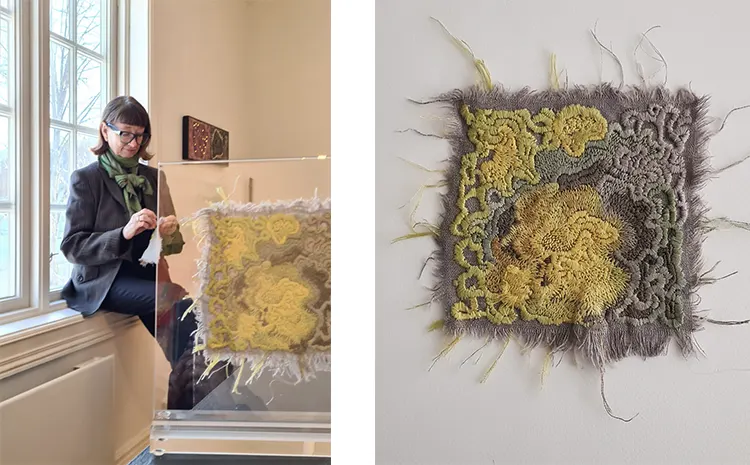
Embroidery: A Meditative Journey into Anne-Kari Jansen’s Mind
Born to a father renowned as both a typographer and typography teacher, Anne-Kari Jansen found herself profoundly molded by his assertion of letters as pivotal cultural conveyors. Her patriarch’s passionate endorsement of typography as an indispensable tool for communication and his relentless emphasis on the historic value of letters to successive generations of Norwegian typographers during the inception of the visual design profession, left an indelible mark on her. Unbeknownst to her, this deep immersion instilled within her a joy of creation and a gratification drawn from manual labour from a tender age.
During her formative years, Jansen was enthralled by her exposure to icons, illuminated handwritten manuscripts, and early printed texts. This fascination, coupled with her exhilarating encounter with the works of William Morris and Eric Gill, esteemed personas of The Arts and Crafts movement in Great Britain, critically shaped her artistic sensibility. Her middle school’s art-centric curriculum, along with a particularly inspiring teacher who intertwined art with music, assigning projects that demanded personal musical interpretation, further fueled her aesthetic ethos.
At present, Jansen is predominantly involved in the realm of embroidery, despite her ongoing exploration of drawing and painting. Her distinguished oeuvre boasts participation in prominent exhibitions such as the Norwegian Association for Arts and Crafts Annual Exhibition in 2021 and the regional Østlandsutstillingen in 2020. At these events, she showcased her remarkable textile works. Beyond these, Jansen has held several solo exhibitions, with her most recent display taking place at Det Gule Huset, Viken, where her textiles held center stage. Additionally, she has significantly contributed to numerous group exhibitions, including BKiB’s member exhibition in 2021 and the Bærum exhibition in 2022 at Kunsthall Bærum.
Jansen’s artistic journey, spanning over two decades, has been punctuated by a recurring theme. This theme was initially triggered by twelve drawings she created for a calendar titled “petrified personalities,” wherein she portrayed different stones from her collection. This thematic thread was only fully realized when she was preparing for her inaugural solo exhibition in 2019. The preparatory process for “the acceleration of gravity” led her to identify the inherent connection between these initial illustrations and the large-scale paintings she was then engrossed in creating.

Abstract Figuration: Nature’s Mirror in Anne-Kari Jansen’s Art
The artistic style of Anne-Kari Jansen is best characterized as abstract figuration, with all her motifs drawing inspiration from nature without resorting to direct depiction. Instead, her works function as introspective mirrors of the mind, emerging from a perpetual dialogue between thought and hand. Images are continuously created and refined from previous works, much like an intricate process of peeling and layering, ultimately leading to the completion of the final piece. She often characterizes her artwork as fieldwork in the expansive world of imagination.
There came a day when Jansen found herself deconstructing a print, repurposing it onto a piece of fabric, and subsequently embroidering upon it. This innovative approach was recognized when two of her early works were chosen for a regional exhibition and subsequently acquired. This validation marked a turning point, as she realized that her textiles could articulate a unique artistic expression. The recognition sparked in Jansen a further exploration of this expressive medium.
Presently, Jansen’s artistic oeuvre orbits around themes of time and existence. The embroidered textiles, particularly those in her “MykOide” series, function as tactile paraphrases of the paintings in the “acceleration of gravity” series. These works symbolize a fall through time and space, suspended in the stasis of a frozen moment. They are also interpreted as time capsules referencing her own life and the broader sphere of women’s practices. They encapsulate lessons learned in childhood, but often sidelined in the passage of life.
In an era dominated by visual noise and subjective impressions, Jansen finds the time-intensive medium of embroidery to be a sanctuary of focus. It serves as a platform to synchronize thought and action, facilitating a contemplative and creative process. Her art seeks to offer a haven for the human mind, evoking both emotional and intellectual responses, whilst also providing a gentle reminder of our transient existence.
Jansen’s textiles are hand-sewn onto a base, typically repurposed from pre-existing materials. The preferred thread is the 6-thread Moulinégarn DCM25, prized for its broad color palette and relative accessibility. Her pieces, varying in size from approximately 15x15cm to 50x70cm, each narrate their own unique stories, inviting viewers to discern and interpret their meanings.
Initiating each new textile piece with a sketch and a conceptual foundation, Jansen allows the work to evolve organically. As the piece advances, forms, colors, and stitches assume their own dynamic autonomy. Certain shapes or surfaces are accentuated with French knots, chain stitches, or back stitches. Contrasting colors may be introduced using a single thread in some sections. The threads trailing from the back contribute to a distinct aesthetic, creating a unique look that underscores the individuality of each piece.
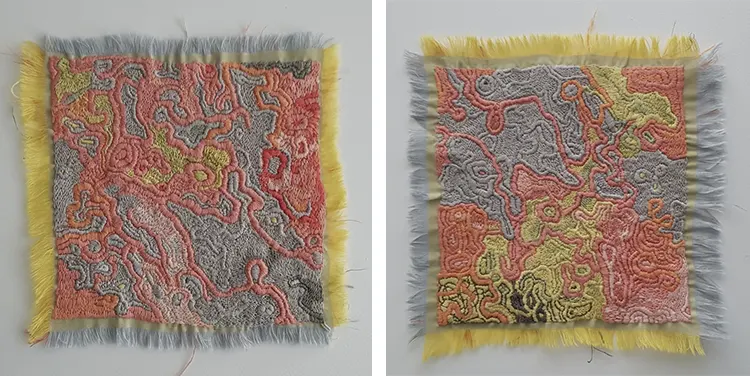
“Sampl” Series: Unraveling the Textured Universe of Anne-Kari Jansen
The signature series, “Sampl,” by Anne-Kari Jansen, comprises an array of textiles stitched on to recycled linen fabric, meticulously torn into squares of 15×15 cm. The textiles, notably “Hypogymnia” and “Xanthoria”, reflect forms and motifs synonymous with nature, meticulously assembled to forge novel wholes. This series represents the preliminary chapter in Jansen’s extensive project that seeks to subtly render the varied textures of nature.
Jansen’s creative sanctum is a model of simplicity, boasting an array of colored pencils, ink, a travel-sized watercolor kit, sketchbooks, and a treasure trove of natural elements including stones, shells, sticks, and lichen. The artist’s current focal point lies in the realm of embroidered textiles, necessitating a trusty “sewing box”. While the dulcet tones of classical music often serve as her creative soundtrack, Jansen craves silence during the early stages of her artistic process.
Handling distractions emerges as an intrinsic component of Jansen’s creativity. Upon experiencing a lull in focus, she strategically sets the piece aside, embarking on a new venture. Upon revisiting the original work, Jansen either declares it complete or resumes her sewing. Jansen firmly believes that creative missteps often pave the way to new artistic directions.
As for artistic influences, the early 20th-century movements such as Art Nouveau, Bauhaus, and the Arts and Crafts movement have left a considerable imprint on Jansen’s artistic sensibilities. Artists including Kandinsky, Käthe Kollwitz, and Hilma af Klint have shaped her unique approach to form and color. Anselm Kiefer’s work “The High Priestess/ Zweistromland” has made a profound impact on Jansen, primarily due to its materiality and relevance to the contemporary age.
One of Jansen’s coveted dream projects involves transforming select paintings into tapestries. However, her immediate attention is trained on small embroideries within the “Sampl” series. The grand ambition is to exhibit these intricate pieces internationally, giving the artist a formidable goal to aspire to.
